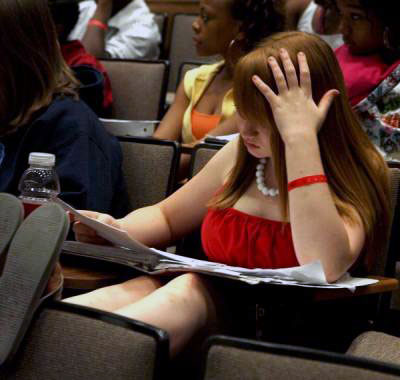All Nonfiction
- Bullying
- Books
- Academic
- Author Interviews
- Celebrity interviews
- College Articles
- College Essays
- Educator of the Year
- Heroes
- Interviews
- Memoir
- Personal Experience
- Sports
- Travel & Culture
All Opinions
- Bullying
- Current Events / Politics
- Discrimination
- Drugs / Alcohol / Smoking
- Entertainment / Celebrities
- Environment
- Love / Relationships
- Movies / Music / TV
- Pop Culture / Trends
- School / College
- Social Issues / Civics
- Spirituality / Religion
- Sports / Hobbies
All Hot Topics
- Bullying
- Community Service
- Environment
- Health
- Letters to the Editor
- Pride & Prejudice
- What Matters
- Back
Summer Guide
- Program Links
- Program Reviews
- Back
College Guide
- College Links
- College Reviews
- College Essays
- College Articles
- Back
Tablet Learning: Is it Right for You?
Materials for college: a fancy backpack, a nice pair of running shoes (for when you’re late for your lecture), dorm decorations, and an iPad. What’s missing from this list? Textbooks. But, maybe they’re not. In that iPad is about 12 textbooks for a completely packed schedule. Across the country, students are beginning to make the switch to electronic textbooks, but schools should make the move to standardize this among their students.
Most students experience how heavy a backpack is every day. Students may be toting several notebooks, various writing utensils, a calculator, and multiple textbooks, roughly 50% of their body weight on their backs. Most of the weight in these bags are the 1,000 page textbooks with solid cardboard covers. The downward force of these mammoths can strain muscles, and irritate spine joints and the ribcage due to distortion of the natural shape of the spine. In the 2011-12 school year, 13,700 students were treated because of these injuries and complications due to a backpack. These side-effects to texbook-toting also cause a forward center of balance, causing student’s overall balance to be impaired. By using e-textbooks, the potential several pounds of weight is compressed down to the weight of the tablet (generally under a pound) and the weight of the digital file (billionths of a billionth of an ounce). But, tablets don’t only hold textbooks, they can also hold PDF’s of homework, notes, and quizzes. Lightening the load on young adults with e-textbooks can make chiropractors’ jobs easier, and keeps you from having to pay them.
While avoiding back problems, e-textbooks on tablets also can improve performance in students. With new interactivity features available on tablets, a student can have a teacher even when he or she isn’t in class. The possibility of embedded video lessons, constantly refreshing problems, or accuracy checkers included would make out-of-class learning much easier to the average student. Tablet textbooks can even help struggling students. With the use of “cloud” servers or other services like dropbox, the curriculum can be individually tailored to a student dependent on their performance in certain areas of the class. Sharing extra problems and offering different explanations to these students is almost like having a tutor, without having to pay for one.
The war between tablets and textbooks is ongoing in high schools and colleges, but ultimately it depends on the preference and situation of the school. Without the proper resources, such as a dependable wireless internet connection, tablets would be much less effective in the classroom. But, if the use of less paper, less injured students, and improved performance, are appealing, it’d be worth it to invest in the resources to make tablet learning possible.

Similar Articles
JOIN THE DISCUSSION
This article has 0 comments.
